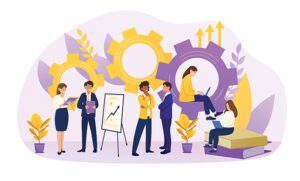Share
Despite all the headlines about self-driving cars and artificial intelligence, it’s far too early for most humans to worry about robots “stealing our jobs.” New technology is often impressive, but it also makes us appreciate where and how actual humans make a real difference.
As HR professionals and business owners work to improve efficiency and engagement, the right HR software is critical. Using technology to empower your employees is the best way to ensure a human-first approach to the employee experience. By taking a human-first approach to HR technology, you’ll be protecting the long-term health of your company.
While utilizing HR technology is a positive step in the right direction, how you use it is even more imperative. Does your company project a human-first approach to HR? Test yourself (and your company) by answering the following questions and discover how HR technology can improve your HR functions by empowering your employees.
Five questions every company should be asking about the employee experience
- Do we support the employee experience with the right tools, access, and processes?
- How do we engage employees better?
- How do we ensure employees are better motivated?
- How do we ensure productivity in a more flexible work environment?
- How can we elevate the employee experience?
How integrated HR technology is the key to empowering employees
Integrated HR technology uses solutions that work together, reducing the need for repetitive tasks like transferring numbers between programs. From onboarding to timekeeping and payroll to benefits administration (and more), compatible software reduces the opportunities for human error.
The right HR technology does way more than just administrative tasks. It empowers employees to be informed and engaged. HR technology should not only be time saving and cost effective, it should also be flexible, intuitive, and scalable to meet your growing workforce demands.
Flexibility and remote work
The right HR software supports collaboration in any work environment, from in office and hybrid work to fully remote. Remote workers should be able to log hours and communicate in a reasonable time frame. The COVID-19 pandemic taught everyone the power of video conferencing, but too much Zoom-ing can lead to video meeting fatigue.
Alongside innovative software, your company needs HR policies that define expectations and set boundaries while keeping everyone on the same page.
Recruiting and onboarding
Recruiting software, such as applicant tracking systems, are essential for making the hiring process easy and more manageable, but the human element to recruiting cannot be overlooked.
How Recruiting Software Changed the Hiring Process
HR technology helps you avoid common onboarding mistakes to ensure your new employees get started on the right foot. Your company makes a PACT with new hires during onboarding. HR software makes it easier to cover key topics like Planning, Administrative, Culture, and Training.
Training and development
Use a Learning Management System (LMS) to begin training before an employee’s first day in the office. The same LMS can help you close skill gaps, cross train departments, and develop potential leaders. Many of the software tools that benefit the company also benefit workers.
Employee self-service
Many outdated HR processes are time consuming and distracting for both HR and employees themselves. It takes time to crunch numbers and look up answers, and it’s tiresome when workers frequently pester HR staff about accrued hours and policy changes.
Self-service portals save time by allowing employees to perform simple tasks for themselves (such as checking pay stubs and PTO accumulation), which decreases the chances for miscommunication.
With HR software administration employees can answer many of their own questions and update their own information to ensure accuracy. Online portals allow workers to check schedules, request time off, and update personal information like a change of address.
The Benefits and Must-Have Features of Employee Self-Service Portals
HR communication
You can’t overstate the importance of effective communication in HR—and how much HR technology makes it easier. In conjunction with management, the development of an internal communications plan is a top priority.
Top Ten Tips for Improving HR Communication
HR technology enables employees with 24/7 online access to handbooks, policies, and other key documentation. HR tasks can also be assigned directly to employees, as well as tracked throughout the process. Alerts, reminders, and messaging capabilities provide an additional communication channel.
Why all businesses need HR technology
HR software does more than improve efficiency. Yes, the automation of routine tasks can save time, and it might even make certain data-entry tasks unnecessary. HR professionals can reallocate those work hours into more fulfilling and impactful ways.
Human Resource Management: How it Works, Main Objectives, and HR Technology
Instead of spending hours duplicating data and looking up information, HR leadership can focus on helping people, improving the employee experience, and ensuring HR’s goals and company’s goals are properly aligned.
- Data integration with HR software gives new insights into worker performance and overall efficiency
- HR technology can also help manage labor cost more effectively
- HR technology integration enables your company to work smarter with less work
- HR technology not only ensures accurate and up-to-date information, it also keeps employee information safe and accessible
The present (and future) of HR
The past several years brought unprecedented changes, but 2023 looks like a more familiar “labor shortage.” As more baby boomers retire from the workforce, then recruiting costs will stay high. Regardless, many companies have seen the importance of retention and employee satisfaction.
The Future of HR: New Roles Emerge to Boost Engagement and Retention
If you can develop current workers and help them grow with the company, then you can build a stronger foundation for the company’s future. It’s not just about avoiding the costs of recruiting and training replacements; everyone benefits when short term “jobs” become fulfilling and satisfying careers.
Recession, Retention, DEI, and More: This Year’s Top HR Trends
More than ever, Human Resources staff need to be nimble. You need to respond to emerging changes like pay transparency and social injustice. The right HR software takes a lot of the tasks and worry off of HR’s plate and allows them to shift priorities somewhere more valuable. As workplaces continue to change, don’t forget to update your employee handbook this year.
Discover how Netchex can help empower your employees with HR technology:
Related articles

What’s Next in HR? Top 10 Workplace Trends for 2025

HR Software ROI: Why HR Tech Is an Essential Investment

Change Management Strategies for Your HR Technology Rollout Plan

